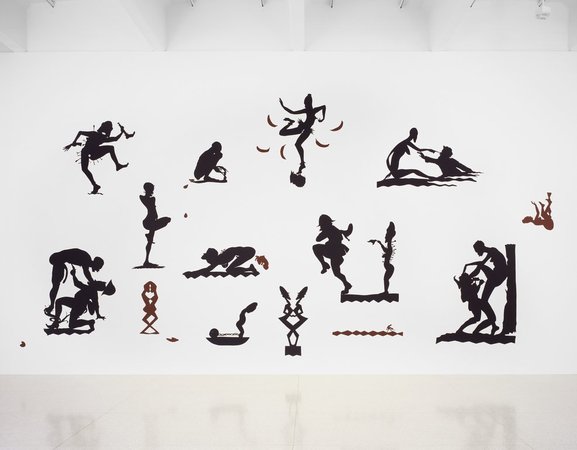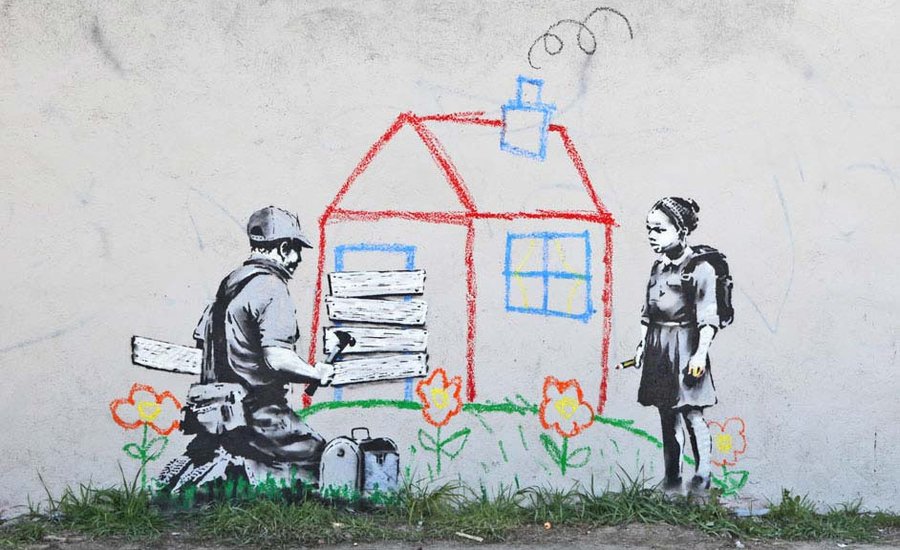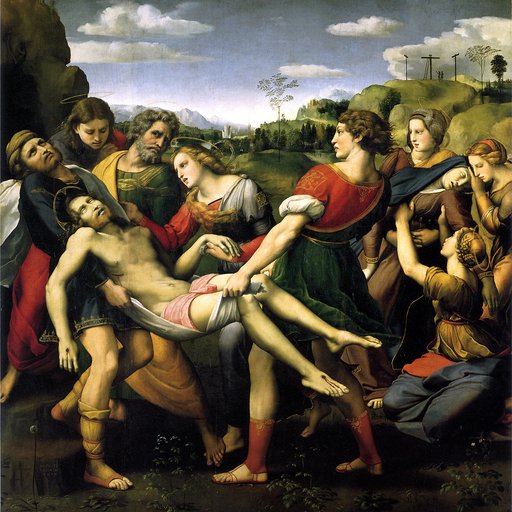Artists have long used their work as a site to express their politics. Though their historical, social, and geographic contexts differ widely, such political works can, at their best, challenge long-held beliefs and spark meaningful dialog amongst peers and viewers alike. In the current climate, this consciousness-raising effort seems as vital as ever, and artists are taking notice . In this excerpt from Phaidon’s The 21 st Century Art Book , we look back at some of the most interesting and important examples of political art from the past decade and a half. For more information about making effective political art, check out our new guide here .
I THOUGHT THEY WERE CONVICTS
Harun Farocki
2000

Grainy surveillance footage from a maximum-security prison captures the dramatic moment when an inmate is shot dead by guards. The shooting of William Martinez in 1989 was one of many similar incidents at California State Prison, which became notorious for its brutal conditions. Farocki’s film focuses on the investigation into the shootings, revealing that guards intentionally set up fights between prisoners, allowing them to escalate before interceding with live ammunition. The prison footage is juxtaposed with computer-generated graphics based on the movements of supermarket shoppers. In this way Farocki explores the power relationship between the observer and the observed, drawing parallels between the role of surveillance in the lives of prisoners and those of everyday citizens. The power of images has been a central concern for the German filmmaker since the late 1960s. His film essays and documentaries examine systems of control and manipulation, and the influence of technology on human behavior.
ENDLESS CONUNDRUM, AN AFRICAN ANONYMOUS ADVENTURESS
Kara Walker
2001

A group of black silhouetted figures are shown leaping and cavorting, and engaging in lewd sexual acts. Walker has used black paper cut-outs, which are usually fixed directly onto the gallery walls, since the early 1990s. Silhouette art peaked in popularity in the seventeenth and eighteenth centuries, and Walker has reappropriated the style to create imagery that is often shocking and uncomfortable, addressing issues of race and gender, power and sexuality. This piece was originally commissioned by the Swiss museum Fondation Beyeler, and was created in response to its collection of African art. In it, Walker examines the influence of African tribal art on Modern artists, as well as looking at the wider appropriation of black creativity in Western art and culture. The piece includes Walker’s recreations of works from the museum’s collection, including Augustin Rodin’s
Iris
(1895), while the title references the Constantin Brancusi sculpture
Endless Column
(1918).
WHERE WE COME FROM (HANA)
Emily Jacir
2001–3

Jacir asked Palestinians who were prohibited from entering their homeland, or who experienced restricted movement within it, the question “If I could do anything for you, anywhere in Palestine, what would it be?” In 2002 using her US passport, which at the time entitled her greater mobility through Israeli borders and checkpoints, the artist carried out these request (due to increased restrictions in the region the piece would be impossible to make today). The installation
Where We Come From
is a photographic, text, and video documentation of these actions. The requests were mostly simple, often poignantly so. Many were related to family: a kiss for a mother, an up-to-date photograph of a brother’s children. Others were almost banal, with one person just asking that Jacir do something “normal” in Haifa. The installation explores questions of displacement and how conflict affects individuals on a personal and everyday level. Silenced historical narratives, resistance, and movement are recurring concerns in Jacir’s works.
MAY MY SITUATION BE BETTER IF I AM IN CHINA?
Bandi Zhao
2003

The artist clutches a toy panda as he sits in a London street talking with a homeless man who asks: “May my situation be better if I am in China?” The question, printed on the photograph in English and Chinese, is left unanswered, though Bandi’s expression suggests an unfavorable response. The sardonic tone here is typical of the artist’s photographs, which depict him and his panda in everyday scenarios. In some works comic book speech bubbles give voice to the toy, who discusses topical issues such as war, terrorism, pollution, and public health. Drawing from the visual language of advertising and public information campaigns, Bandi’s witty and subversive works critique the absurd and often irrational aspects of government propaganda in his native China. While Bandi has exhibited in galleries internationally since the early 1990s, many of his works appear as public posters, allowing his political commentaries to reach a mass audience.
HATE AND POWER CAN BE A TERRIBLE THING
Tracey Emin
2004

A textile wall hanging, this work uses an old pink woolen blanket cut and extended, with cotton as backing, onto which a series of statements are stitched. Emin has used quilting and appliqué in her work since her career-launching solo exhibition in 1993, and is one of a number of women artists to use traditionally feminine crafts to express complex emotions and sexuality. A central player in the loose group of artists commonly referred to as the Young British Artists (YBA) , Emin’s work is often based on self-exposure, yet this piece is overtly political. Amongst the statements in block capitals, a small section of white fabric features a handwritten text: “1982, A year so many conscripts did not got home – Because you, you killed them all”. This, combined with the use of the British Royal Navy’s White Ensign flag, suggests a reference to the Falklands War and the ever-divisive then-Prime Minister, Margaret Thatcher.
IN THE NEAR FUTURE, NEW YORK
Sharon Hayes
2005

Five simultaneous slide projections document a performance-based artwork in which Hayes held up banners carrying anachronistic slogans relating to protest actions from previous eras. The original, collaborative performance took place in various public locations, the sites of historical actions, in New York in 2005. It was then adapted for similarly significant locations in Brussels, London, Warsaw, and Vienna. The intention was not to re-enact the protests but to commemorate those events and to assert the possibilities for future dissention. The artist was also exploring the idea of the protester as an agent of change, the protest sign as a method of communication and the political construction of public space and public speech. Hayes’s work combines performance art with direct engagement with the public and her principal concern is the way in which we participate, as both speakers and listeners, in the political discourse of our own time.
WORLD MAP
Ai Weiwei
2006

Thousands of sheets of fine cotton cloth have been cut into the shape of a world map and layered precisely to create a three-dimensional sculpture. Actual geographical borders between countries are ignored in favor of the straight edges of the fabric, which divide the map. Using a familiar image, Ai has constructed a complex work that is by design very labor-intensive to install, thus evoking China’s status as a source of cheap workers for the garment industry. The difficulty of placing the elements accurately also introduces issues of international relations and global trade. The historical, socio-political, and economic conditions of contemporary China frequently serve as starting points for Ai’s art and he has become internationally known for his critical stance. He uses a diverse range of techniques and materials, often drawing on Chinese traditions, and although politically motivated, he uses humor and metaphor, producing work that is poetic and subtle in its content, with formal aesthetic qualities.
THE CAPITAL OF ACCUMULATION
Raqs Media Collective
2010

This double-screen video projection weaves together filmed images of Berlin, Mumbai, and Warsaw to imagine a shared economic, social and urban history of the twentieth century. Its title is a reversal of Rosa Luxemburg’s
The Accumulation of Capital
(1913), which described the rapacious nature of capitalism: its tendency to commandeer resources and its intolerance of other economic models. The film reflects on Luxemburg’s theories and includes a parallel narrative exploring her violent death and the disappearance of her body. The double screen sets up a dialogue between images, narrative, and text, making a work that is hauntingly poetic and polemical. Raqs Media Collective, a group of three media practitioners, operates at the intersections of contemporary art, historical and philosophical enquiry, and activism. In 2000 they co-founded the Sarai Programme at
Delhi’s
Center for the Study of Developing Societies, which encourages creative collaboration between the visual arts and other disciplines concerned with urban spaces and cultures in South Asia.
UNTITLED (LA, 2011)
Banksy
2011

A young girl, pencil in hand, watches in annoyance as her simple drawing of a house is boarded up. Applied directly to a Los Angeles wall, this mural is one of several outdoor works by Banksy that appeared across the city in early 2011. While the figures have been rendered using the artist’s familiar stencil technique, the child’s house has been drawn freehand with colourful crayon. With characteristically acerbic wit, the work addresses the issue of foreclosure that plagued the U.S. housing market during the early 2010s, speaking bluntly of the callousness of those involved in repossessing people’s homes. Appearing on city streets throughout the world, Banksy’s satirical art combines subversive humor with social and political commentary. Starting out as part of the British graffiti subculture in Bristol in the early 1990s, he has since become one of the world’s most famous street artists. Preferring to remain anonymous, speculation is rife regarding his true identity.
CIVIL TAPESTRY (DIRTY YELLOW)
Theaster Gates
2012

A decommissioned fire hose is the unusual material used to make this work. The formal arrangement, made from long strips of the flattened hose, recalls American abstract art of the early 1960s, especially the famous stripe paintings by
Frank Stella
. Yet it is to another event from this period that Gates’s work points: the violent hosing of civil-rights demonstrators by police in Birmingham, Alabama, in 1963. The enduring challenge of race and class inequality in American cities is a driving force for Gates, whose sculptures, installations, and performances are part of a larger vision that aims to effect genuine social change. Originally trained as an urban planner, the Chicago-based artist uses funds raised from the sale of his works to assist in the regeneration of deprived neighborhoods. Collaborating with architects, craftspeople, and unemployed laborers, Gates buys and renovates derelict properties. Salvaged materials from the buildings are then used to create new artworks, and so the cycle continues.
























